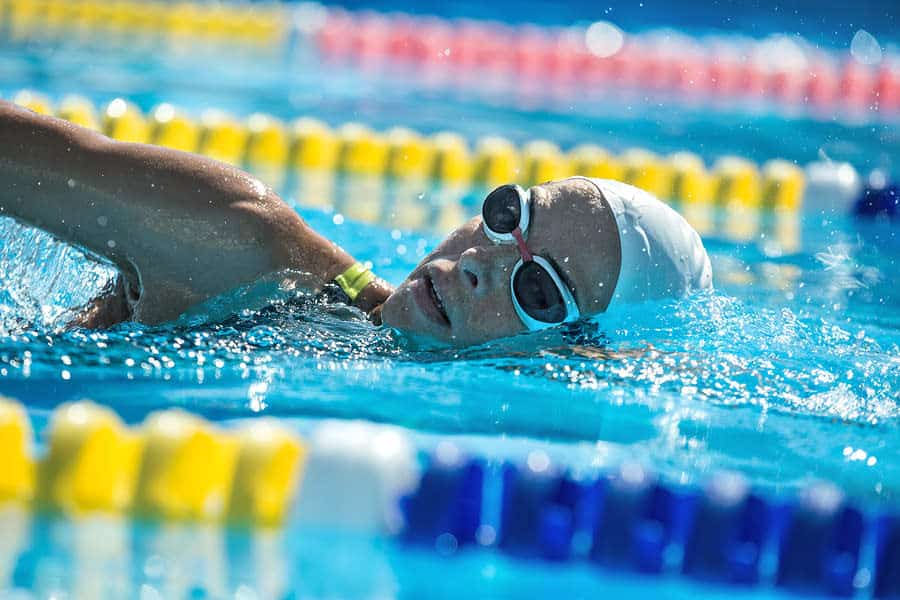One of the most valuable things that swimmers need to learn is proper breathing. It’s not just about taking air in and out of the lungs. It’s a complex, intelligent process that gives an edge to swimmers, and makes them perform better in and out of their game.
Unfortunately, many beginners (and even experienced swimmers) use incorrect breathing techniques in their strokes. Learning proper breathing is the first step to correcting this problem.
What Breathing Is Really All About
Knowing how to breathe properly starts with understanding what breathing really is. Most people believe that being out of breath means they aren’t getting enough oxygen. The truth is that it’s really excessive carbon dioxide (CO2) that is urging you to breathe, not insufficient oxygen (O). As your body breathes and takes in enough oxygen, it creates carbon dioxide waste products in your body. This accumulates in your lungs and blood stream, and your brain triggers your body to take in air.
What happens when your body has too much CO2 in your body? It quickly tires out. Have you ever seen well-trained triathletes suddenly stop swimming and take a rest? Chances are they’ve been holding their breath for a long time. This is why breathing is very important for swimmers, and the only way to reduce accumulated carbon dioxide in your body is to exhale it through your nose.
How Proper Breathing Helps Swimmers
Proper breathing—especially exhaling—provides a lot of benefits for swimmers:
- It helps you to swim faster. Having lungs full of air makes your chest too buoyant, making your body move like a seesaw around your central core. This instability causes your legs to sink in the water, creating unnecessary drag. Your body feels heavier and less stable, resulting to reduced speed.
- Swimming releases tension, especially when you exhale properly. It helps you create easier, longer, and more fluid strokes without too much effort, so you use your energy effectively.
- Many scientific tests have proven that breathing relieves stress. This makes you calmer, and improves your mental clarity, focus, and concentration.
The Most Common Breathing Mistake made by Swimmers
Swimmers should always exhale when their face is in the water. This is especially true when doing freestyle swimming. Many swimmers know this, but their tendency is to hold their breath underwater, even subconsciously.
Another common mistake is inhaling and exhaling through the mouth when turning their heads above the waterline. Not only will this make them feel tense and panicky, it will also cause their legs to sink and drag their body down. Consequently, it reduces your swimming speed.
Sink First Before You Swim
Oftentimes, the “fear of sinking” is what drives swimmers to tense up and exhale improperly. This exercise is a good way to overcome your fear of sinking while assessing how well you exhale.
Go to the deep end of the pool. Inhale, and allow yourself to sink. Once your head is in the water, forcefully exhale through your mouth or nose. You will know if your exhalations are strong if you’re sinking down. If not, then you might sink a bit and then go back up again. When this happens, go back to the surface again and keep exhaling until you sink.
The best way to relax while sinking is to feel like your entire body and muscles are going limp. Let go, and allow yourself to sink. When you get accustomed to sinking, then you don’t fear it as much. This helps you to feel more relaxed when you breathe.
How to Breathe Correctly
Loosen Up.
It’s important to relax the neck, face, mouth, and jaw to help you breathe properly. Think about how your facial muscles feel when you’re jogging or doing an aerobic exercise. It should be the same when you’re swimming.
When you strain your facial muscles, your tendency is to hold your breath underwater. It’s highly ineffective because it forces you to inhale and exhale fast when your head goes above the water to breathe. This makes you feel anxious, and can exhaust you in the long run.
Exhale.
Your mouth should be slightly open, with some air going out between your lips as soon as your face hits the water. It’s important not to blow your air out too quickly. Quick exhalations can cause you to hyperventilate, or take deep, fast breaths. It can be relatively harmless, but prolonged hyperventilation can cause shallow water blackout. This condition unknowingly robs you of oxygen so you pass out and drown.
Exhaling slowly allows you to become more aware of any facial tension, particularly around your lips, teeth, and mouth. Increase your exhalation as your face begins to leave the water, and then remove the remaining air with a strong puff as you turn your head to breathe. A lot of swimmers use both their nose and mouth when doing this.
There is not one strict rule about where to exhale. You can do it through the nose and/or mouth. Choose whichever is comfortable for you.
Inhale.
Inhaling naturally occurs after you’ve properly exhaled in the water. The only thing you need to keep in mind is to inhale quickly as soon as your mouth clears water.
Lengthen Your Exhalations.
The longer you exhale, the more easily the air exchange happens. Ideally, you should exhale twice as long as your inhalations.
Improve Your Breathing Technique with Blue Buoy Swim School
Breathing is one thing all swimmers need to master. And if you need a coach to teach you proper breathing techniques, the Blue Buoy team will be there to guide you. Give us a call, and we’ll help you learn to breathe correctly in no time.



I like this school pls
Dear sir/madam how can you help me, im living with disability age 53years. Stay at Durban Umlazi
Im looking for the place where can i joined the swimming lessons.
Regards
Simelane
MR